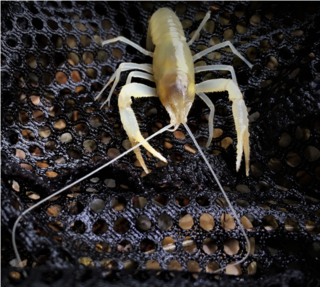
Cambarus is a large and diverse genus of crayfish from the United States and Canada. The adults range in size from about 5 cm (2.0 in) up to approximately 15 cm (5.9 in).

The Everglades crayfish, sometimes called the Florida crayfish, the blue crayfish, the electric blue crayfish, or the sapphire crayfish, is a species of freshwater crayfish endemic to Florida in the United States. Its natural range is the area east of St. Johns River and all of Florida from Levy County and Marion County southwards, as well as on some of the Florida Keys. It is included on the IUCN Red List as a species of Least Concern. The blue crayfish is frequently kept in a freshwater aquaria. In the wild, this species varies from brown-tan to blue, but an aquarium strain has been selectively bred to achieve a brilliant cobalt blue color.
Cambarus cymatilis, the Conasauga blue burrower is a species of burrowing crayfish in the family Cambaridae. It is native to Tennessee and Georgia in the United States. The common name refers to the Conasauga River.
Cambarus deweesae, the valley flame crayfish, is a species of crayfish in the family Cambaridae. It is found in Kentucky and Tennessee.
Cambarus nerterius, the Greenbrier cave crayfish, is a species of crayfish in the family Cambaridae. It is endemic to the state of West Virginia in the United States. It is found only in or immediately adjacent to caves in Greenbrier and Pocahontas counties, and is included on the IUCN Red List as a Near Threatened species.

Cambarus scotti, the Chattooga River Crayfish, is a species of crayfish in the family Cambaridae. It is endemic to Alabama and Georgia. The common name refers to the Chattooga River. The original specimens were collected from Clarks Creek in Chattooga County.
Cambarus subterraneus, the Delaware County cave crayfish, is a species of crayfish in the family Cambaridae. It has been found only in three caves in Delaware County, Oklahoma.
Cambarus tartarus, the Oklahoma cave crayfish, is a species of crayfish in the family Cambaridae. It is endemic to two caves in Delaware County, Oklahoma in the United States.

Cambarus unestami, the blackbarred crayfish, is a species of crayfish in the family Cambaridae. It is native to Alabama and Georgia in the United States.

Cambarus zophonastes, also known as the Hell Creek Cave Crayfish, is named for its original location of discovery, Hell Creek Cave. It is also found in other similar habitats in Stone County and Marion County, Arkansas. These habitats include springs and caves such as Nesbitt Spring Cave in Stone County. C. zophanastes is critically endangered according to the IUCN. C. zophanastes is also protected by the ESA as an endangered species. Currently conservation efforts focus on monitoring populations, reducing disturbances, and monitoring water quality. More research has to be conducted to better understand and conserve the species.
Procambarus milleri, the Miami cave crayfish is a species of crayfish in the family Cambaridae. It is endemic to Florida, where it is known from 14–15 sites in Dade County, Florida, and is listed as an endangered species on the IUCN Red List.
Cambarus pecki, sometimes called the phantom cave crayfish, is a species of crayfish in the family Cambaridae. It is endemic to Alabama where it is found in three unconnected caves in the Tennessee River drainage in Colbert County, Lauderdale County, and Morgan County.
Cambarus speleocoopi, the Sweet Home Alabama cave crayfish, is a small, freshwater crayfish endemic to Marshall County, Alabama in the United States. It is an underground species known only from 4 caves.
Cambarus laconensis, the Lacon Exit cave crayfish, is a small, freshwater crayfish endemic to northern Alabama in the United States. It is an underground species known only from a single cave along the southern border of the Highland Rim in the southern Appalachians.
Cambarus tenebrosus, the cavespring crayfish, is a freshwater crayfish native to Alabama, Kentucky, Tennessee, Ohio and Indiana in the United States. It is a facultative cave-dwelling species known from 84 caves over its range and 20 surface locations in the Cumberland Plateau.
Cambarus setosus, the bristly cave crayfish, is a freshwater crayfish native to Missouri and Arkansas in the United States. It is a cave-dwelling species known from 164 localities with the majority on the Springfield Plateau in southwestern Missouri.
Cambarus veitchorum, the White Spring cave crayfish, is a small, freshwater crayfish endemic to Limestone County, Alabama in the United States. It is a cave-dwelling species known from only one cave, the White Spring Cave.

Cambarus hamulatus, the prickly cave crayfish, is a freshwater crayfish native to Tennessee and Alabama in the United States. It is a cave-dwelling species known from 40 caves across its range.

Orconectes sheltae, the Shelta Cave crayfish, is a small, freshwater crayfish endemic to Alabama in the United States. It is a cave-dwelling species known from only one cave, Shelta Cave in Madison County, Alabama. This cave is also home to O. australis and Cambarus jonesi.







